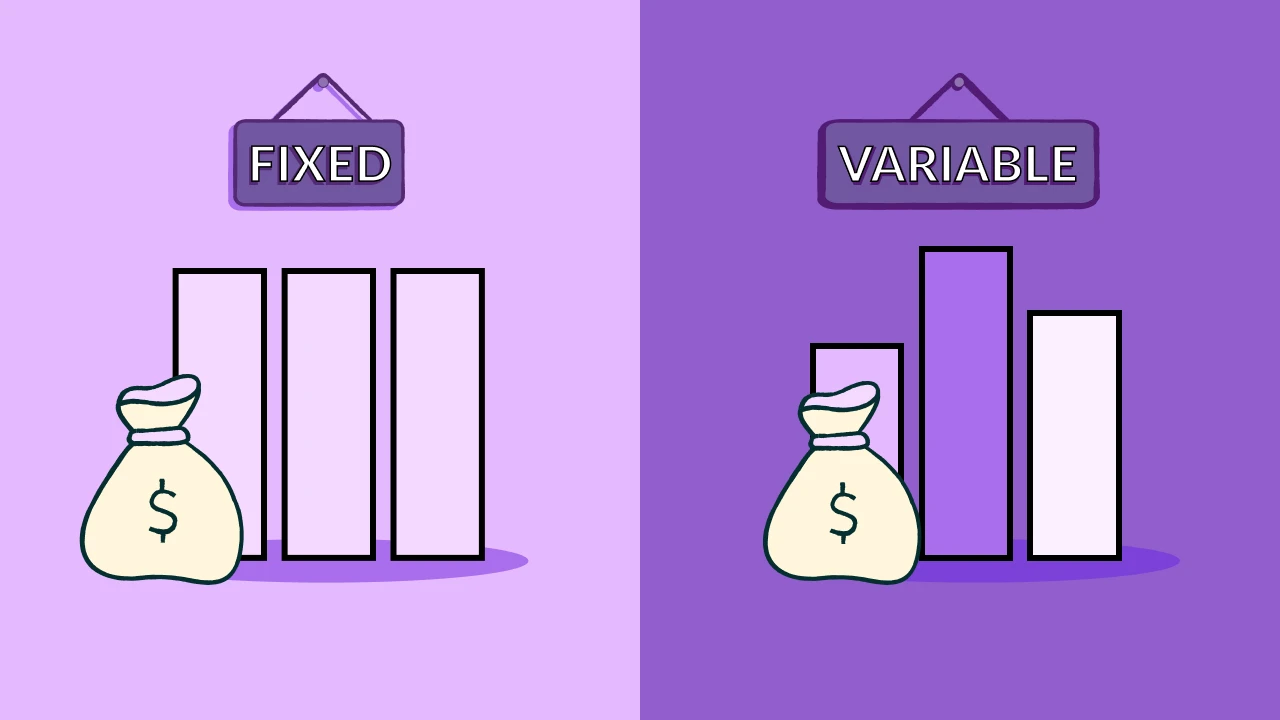Related Articles
Fixed vs Variable-Rate Loans – Understanding Rate Types
Jenius Bank Team
Updated 2/11/2025
• Originally Published 2/29/2024
Borrowing & CreditBanking 101
Before taking out a loan, check what type of rate it carries and how it could impact your payment.When you apply for a loan, you tend to encounter two different interest rate types: fixed and variable. Understanding how these rates work is essential in choosing the right loan type for you. Let’s look at the ins and outs of fixed-rate and variable-rate loans so you’re better prepared when shopping for your next loan.
Key Takeaways
- Fixed-rate loan rates stay the same during the entire term of the loan and only change if you refinance the loan.
- Variable-rate loan rates may fluctuate over time based on the market rate.
- Fixed-rate loans are sometimes preferred for the fixed payment amounts throughout the term. But variable-rate loans are sometimes preferred because if market rates drop, the rate on the loan may drop too!
What Is a Fixed-Rate Loan?
A fixed-rate loan has an interest rate that stays the same for the duration of the loan’s term. Remember, rates are expressed as Annual Percentage Rate, or APR. The rate you receive when you apply for and accept the money is the rate you pay until you pay off the loan. And your rate stays steady even if the market rate changes. Some of the most common fixed-rate loans include:- Fixed-rate mortgages
- Auto loans
- Some student loans
- Fixed-rate personal loans
What Is a Variable-Rate Loan?
Variable-rate loans have rates that may change throughout your repayment term. These rates are impacted by the market rate, also known as the federal funds rate. The federal funds rate is set by the Federal Reserve and is the rate at which banks borrow money. The most common types of variable-rate loans include:1- Adjustable-rate mortgages
- Some student loans
- Variable-rate personal loans
How Do Variable-Rate Loans Work?
As mentioned, variable-rate loans are commonly tied to the federal funds rate. When this rate increases, rates on variable-rate loans often increase as well. And when the Fed lowers rates, the rates on variable-rate loans often drop.This lets borrowers take advantage of potential savings if rates drop after they take out their loan. However, it also exposes them to the risk of a rate increase if the Fed raises rates. Additionally, borrowers may see fluctuations in their payments over time, which may make it harder to manage their bills.The starting rate on variable-rate loans is known as the initial rate. To entice borrowers, the initial rate is usually set lower than rates on fixed-rate loans and remains constant for a period, often ranging between six months and 10 years, depending on the product.3 At the end of the initial rate period, the lender has the right to adjust the rate.4Variable-rate loans, such as adjustable-rate mortgages, may have caps established by the underwriter. In general, variable-rate loan caps are based on the borrower’s credit profile.5 Caps limit how much the loan’s rates are able to change and are disclosed in your loan agreement, as required by the Truth In Lending Act.6There are a few types of caps, including:7- Initial. This determines the maximum amount that your rate could change after your initial rate expires.
- Periodic. This outlines the amount that your rate could change during adjustment periods throughout the year.
- Lifetime. This limits the maximum amount that your rate could increase over the life of your loan.
Variable vs Fixed-Rate Loans – Which Is Better?
There’s no one-size-fits-all approach here. Both loan types may work well, depending on your situation.| Loan Type | Pros | Cons |
|---|---|---|
| Fixed-Rate | Predictable payments.You may be able to lock in a lower rate before market conditions change. | Rates tend to be higher than initial or promotional rates on variable-rate loans.If market rates drop, you’re stuck with a higher rate unless you refinance. |
| Variable-Rate | Usually a lower initial rate than fixed-rate loan.Rates may drop, potentially saving you money. | Rates may increase, increasing your payment amount and total loan cost.Less predictable payments |
Which Rate Type Is Right for Me?
Both types of loans may help you get the financing you need. Fixed-rate loans give you access to more predictable payments but may lock you into a higher rate if the market rate drops. Variable-rate loans may offer lower rates upfront than are currently available on fixed-rate loans, but you could end up paying more over time if rates rise. Before you submit your application, consider the following factors.8- Overall costs: Consider how each loan type may impact your financial situation before you apply. Review the term lengths, fee structure, and watch for any penalties. In some instances, a variable interest rate loan may offer enough upfront savings that it makes the most sense. For other borrowers, the predictability of a fixed-rate loan may offer peace of mind.
- Your credit score: Before you begin researching your loan options, review your credit score to get an idea of what rates you may be offered. The higher your credit score, the more likely you are to qualify for a lower rate on a fixed-rate loan.
- Market conditions: While it’s impossible to predict future market conditions with certainty, take a moment before signing on the dotted line to research the recent trends in market rates. In a low-rate environment, locking in a low rate on a fixed-rate loan could be a smart move. If rates are trending down, going with a variable-rate loan could end up working in your favor.
- Length of the loan: If you’re looking at loans with a short payoff term, such as a year, choosing a variable-rate loan may be the better option, since there may only be a few adjustment periods. Longer-term loans may benefit from a fixed rate since the predictable payments are easier to work into your budget .
